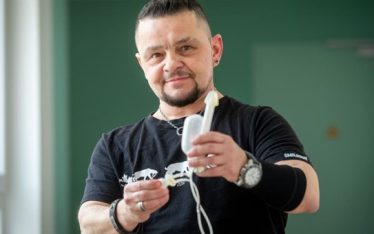Professor Vincent Casoli and Dr. Grégoire Capon
On Tuesday, September 6, 2016, at the Centre Hospitalier Universitaire (CHU) Pellegrin of xBordeaux, plastic surgeon Professor Vincent Casoli and urological surgeon Dr. Grégoire Capon implanted a penile implant designed for phalloplasty, the ZSI 475 FTM L150 (15 cm).
The patient had a 12 cm neophallus (from phalloplasty) with a right neuromuscular pedicle and a sack large enough to accommodate the penile implant’s pump on one side and a testicular prosthesis on the other side.
The patient arrived at the hospital the day before the surgery and the standard procedure was followed: The genitals had been shaved eight days earlier. Baths were given applying Betadine (soap solution) the day before and on the morning of the surgery.

This patient was the first surgery of the day, reducing the risk of infections. For the surgery, the patient was placed in a supine position and received general anesthesia. A double washing with Betadine was performed on the genital area, and then Betadine was applied copiously in the form of a “plaster.”
The legs were arranged so as to expose the external genitals and the iliac fossa. Inserting the Foley 16 Fr CH catheter proved difficult, and Dr. Capon opted to use a Mercier 14 Fr CH catheter instead, with the intention to customize the urethra during the surgery.
First stage: dissection
The vascular pedicle was located on the right side. To avoid the risk of cutting it, a lateral incision was made in the left part of the neophallus. This lateral incision helped expose the pubic symphysis well above the neo-urethra. Nine square centimeters were prepared to receive the base of the penile implant.

Dr. Capon and Prof. Casoli proceeded to make two compartments to house the penile implant pump on the left and a testicular prosthesis on the right. The two surgeons made a left inguinal incision to enter the pelvis and prepare a space for the device. Finally they penetrated the phalloplasty with Mayo scissors. Carefully they were able to reach the end of the phalloplasty.
They then proceeded to dilate the neophallus using Hegar dilators of 8 to 25 mm. A good dilation up to 25 mm permits the penile implant and crown to pass easily toward the glans. If dilation is insufficient, the glans of the implant will not position itself correctly in the neophallus, which will leave the glans with a “soft” aspect (known as “floppy glans syndrome”).
The total length of the neophallus and the base of the implantation on the pubis measures 14 cm. A penile implant of 15 cm was chosen, the ZSI 475 FTM L150, because it adjusts in size from 14 to 16 cm. The whole area was washed with a solution of 10 mg/ml of rifampicin and 1 mg/ml of gentamicin to reduce the risk of infection.
Second stage: Preparation of the ZSI 475 FTM penile implant for the phalloplasty
The components were prepared with an injectable saline solution and then submerged in a solution of gentamicin and rifampicin (10 mg/ml + 1 mg/ml). The ZSI 475 FTM implants are covered with PVP (polyvinylpyrrolidone), a hydrophilic surface that “absorbs” the antibiotics to fight against contamination during the surgery.

Third stage: Insertion of the ZSI 475 FTM penile implant
The empty device was inserted into the pelvis via the inguinal incision. It was filled with 60 ml of saline solution, and then the inguinal incision was closed. The reinforced tube was inserted below the skin until it reached the lateral incision on the left side of the phalloplasty.
The interior of the phalloplasty was washed with a solution of rifampicin (10 mg/ml) and gentamicin (1 mg/ml). Thanks to the good dilation achieved with the Hegar 25 mm dilators, the ZSI 475 L150 penile implant was easily introduced into the phalloplasty using the insertion device. The glans was correctly positioned at the end of the neophallus. A test inflation was performed.
The implant was deflated, and Prof. Casoli attached the base with six stitches of Mersuture-type non-absorbable thread. The scrotum was also washed with the mixture of rifampicin and gentamicin to reduce the risk of infection. The pump was easily inserted into the left scrotum. A testicular prosthesis was placed in the right. The pump was connected to the device via the connectors. Another erection test was performed with the base attached to the pubis. The implant allowed the neophallus to achieve a good erection.
Fourth stage: Closing
After a final washing with the mixture of rifampicin and gentamicin in the lateral incision, Prof. Casoli attached the pump to the lower part of the left scrotum and joined the tissues above the pump compartment. Then the lateral incision was closed with Vicryl sutures. And the skin was immediately closed with separate stitches.
A last erection test was performed to verify the accessibility of the pump. The bulb of the ZSI 475 FTM penile implant’s pump sits easily accessible in the lower part of the scrotum. The deflation valve, located just above the bulb, is also easy to access.
After the surgery, the catheter was removed. No draining was required as hemostasis was well-controlled. The patient will be able to use the implant within six weeks, once the area has healed sufficiently.
Post-operation: Monitoring
The patient simply left the hospital and arrived home without inconvenience. He returned twice, to have the stitches removed and to learn how to use the implant, including how to inflate and deflate it.

ZSI is the only European manufacturer of artificial urinary sphincters and of malleable and inflatable penile implants, as solutions for male urological problems (incontinence), sexual complications (Erectile Dysfunction), and gender identity procedures (prostheses for trans men and women).






